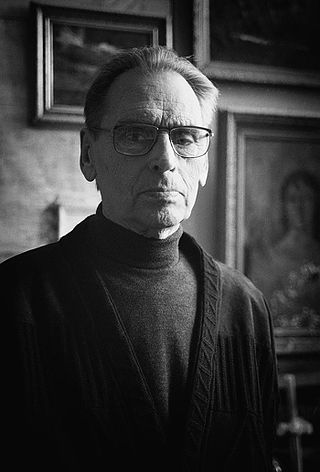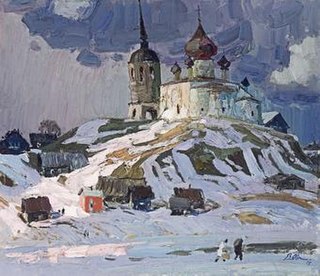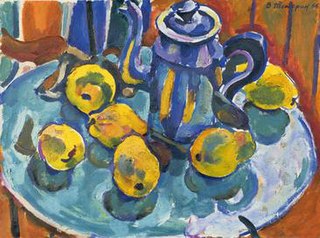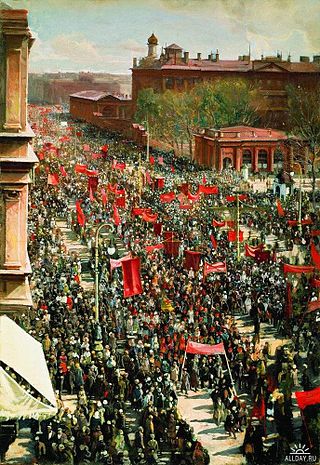| Monument to Lenin | |
|---|---|
 | |
| Artist | Sergei Merkurov |
| Year | 1946 |
| Location | Boulevard of Taras Shevchenko, Kiev |
The year 1946 was marked by many events that left an imprint on the history of Soviet and Russian fine arts.
| Monument to Lenin | |
|---|---|
 | |
| Artist | Sergei Merkurov |
| Year | 1946 |
| Location | Boulevard of Taras Shevchenko, Kiev |
The year 1946 was marked by many events that left an imprint on the history of Soviet and Russian fine arts.

Lev Alexandrovich Russov was a Soviet Russian painter, graphic artist, and sculptor, living and working in Leningrad, a member of the Leningrad Union of Artists and representative of the Leningrad school of painting, most known for his portrait painting.

Nikolai Matveevich Pozdneev was a Soviet Russian painter, living and working in Leningrad, a member of the Leningrad Union of Artists, representative of the Leningrad School of Painting, most known for his genre and still life paintings.

Nikolai Efimovich Timkov was a Soviet Russian painter, Honored Artist of Russian Federation, and a member of the Saint Petersburg Union of Artists. He lived and worked in Leningrad and is regarded as one of the leading representatives of the Leningrad School of Painting, worldwide known for his landscape paintings.

Alexander Nikolayevich Samokhvalov was a Soviet Russian painter, watercolorist, graphic artist, illustrator, art teacher and Honored Arts Worker of the RSFSR, who lived and worked in Leningrad. He was a member of the Leningrad branch of Union of Artists of Russian Federation, and was regarded as one of the founders and brightest representatives of the Leningrad school of painting, most famous for his genre and portrait painting.
Leonid Anisimovich Tkachenko was a Soviet and Russian painter. A member of the Saint Petersburg Union of Artists, he lived and worked in Saint Petersburg, regarded as one of the leading representatives of the "left" wing of the Leningrad school of painting.

Malaya Sadovaya Street is a 1979 oil painting by the Russian artist Alexander Semionov, depicting Malaya Sadovaya Street in Leningrad on rainy day of the end of the 1970s. This cityscape was painted in traditions of the Leningrad School of Painting and Soviet figurative painting of late socialist realism with their typical synthesis of realistic and impressionistic traditions to create an image of modernity.
The year 1955 was marked by many events that left an imprint on the history of Soviet and Russian Fine Arts.
The year 1954 was marked by many events that left an imprint on the history of Soviet and Russian Fine Arts.
The year 1952 was marked by many events that left an imprint on the history of Soviet and Russian Fine Arts.
The year 1950 was marked by many events that left an imprint on the history of Soviet and Russian Fine Arts.
The year 1948 was marked by many events that left an imprint on the history of Soviet and Russian fine arts.
The year 1947 was marked by many events that left an imprint on the history of Soviet and Russian fine arts.
The year 1985 was marked by many events that left an imprint on the history of Soviet and Russian Fine Arts.
The year 1944 was marked by many events that left an imprint on the history of Soviet and Russian Fine Arts.

Lev Konstantinovich Bogomolets was a Soviet Russian painter, a member of the Saint Petersburg Union of Artists, who lived and worked in Saint Petersburg, regarded as one of representatives of the Leningrad school of painting, most famous for his landscape paintings.

Spring is on the way is a painting by the Russian painter Vladimir Ivanovich Ovchinnikov, who lived and worked in Leningrad. A member of the Leningrad branch of Union of Artists of Russian Federation, he is regarded as one of the leading representatives of the Leningrad School of Painting, and is known especially for his landscape paintings.

Quince and Teapot is a decorative still life of Russian painter Victor Kuzmich Teterin, which depicts the quince fruit and teapot on a silver tray.

Vladimir Evgenievich Malevsky was a Soviet Russian painter and graphic artist, a member of the Leningrad Union of Soviet Artists, who lived and worked in Leningrad. Vladimir Malevsky regard as one of representatives of the Leningrad school of painting.
The House of Creativity "Staraya Ladoga" was an all-Russian centre for artistic creativity, which existed in the Volkhovsky District of Leningrad Oblast from the mid-20th century up to the 1990s. It was located opposite the ancient village of Staraya Ladoga on the right bank of the Volkhov River.

The fine art of Leningrad is an important component of Russian Soviet art—in the opinion of the art historians Vladimir Gusev and Vladimir Leniashin, "one of its most powerful currents". This widely used term embraces the creative lives and the achievements of several generations of Leningrad painters, sculptors, graphic artists and creators of decorative and applied art from 1917 to the early 1990s.